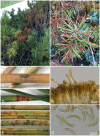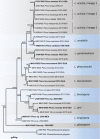Lecanosticta acicola: A growing threat to expanding global pine forests and plantations
- PMID: 31309681
- PMCID: PMC6792179
- DOI: 10.1111/mpp.12853
Lecanosticta acicola: A growing threat to expanding global pine forests and plantations
Abstract
Lecanosticta acicola causes brown spot needle blight (BSNB) of Pinus species. The pathogen occurs mostly in the Northern Hemisphere but has also been reported in Central America and Colombia. BSNB can lead to stunted growth and tree mortality, and has resulted in severe damage to pine plantations in the past. There have been increasingly frequent new reports of this pathogen in Europe and in North America during the course of the past 10 years. This is despite the fact that quarantine practices and eradication protocols are in place to prevent its spread.
Taxonomy: Kingdom Fungi; Phylum Ascomycota; Subphylum Pezizomycotina; Class Dothideomycetes; Subclass Dothideomycetidae; Order Capniodales; Family Mycosphaerellaceae; Genus Lecanosticta.
Host range and distribution: Lecanosticta spp. occur on various Pinus species and are found in North America, Central America, South America (Colombia), Europe as well as Asia.
Disease symptoms: Small yellow irregular spots appear on the infected pine needles that become brown over time. They can be surrounded by a yellow halo. These characteristic brown spots develop to form narrow brown bands that result in needle death from the tips down to the point of infection. Needles are prematurely shed, leaving bare branches with tufts of new needles at the branch tips. Infection is usually most severe in the lower parts of the trees and progresses upwards into the canopies.
Useful websites: The EPPO global database providing information on L. acicola (https://gd.eppo.int/taxon/SCIRAC) Reference genome of L. acicola available on GenBank (https://www.ncbi.nlm.nih.gov/genome/?term=Lecanosticta+acicola) JGI Gold Genome database information sheet of L. acicola sequenced genome (https://gold.jgi.doe.gov/organism?xml:id=Go0047147).
Keywords: Lecanosticta acicola; Mycosphaerella dearnessii; Lecanosticta species; Pinus spp; brown spot needle blight; pine pathogen.
© 2019 The Authors. Molecular Plant Pathology published by British Society for Plant Pathology and John Wiley & Sons Ltd.
Figures



Similar articles
-
The increasing threat to European forests from the invasive foliar pine pathogen, Lecanosticta acicola.For Ecol Manage. 2023 May 15;536:120847. doi: 10.1016/j.foreco.2023.120847. For Ecol Manage. 2023. PMID: 37193248 Free PMC article.
-
Lecanosticta pharomachri and Its Newly Discovered Sexual State Causing a Serious Needle Disease of Pinus spp. in Colombia.Plant Dis. 2022 Jul;106(7):1935-1943. doi: 10.1094/PDIS-08-21-1759-RE. Epub 2022 Jun 16. Plant Dis. 2022. PMID: 35084944
-
First Report of Brown Spot Needle Blight on Pinus thunbergii Caused by Lecanosticta acicola in Korea.Plant Dis. 2012 Jun;96(6):914. doi: 10.1094/PDIS-12-11-1080-PDN. Plant Dis. 2012. PMID: 30727391
-
Remote sensing-based detection of brown spot needle blight: a comprehensive review, and future directions.PeerJ. 2025 May 22;13:e19407. doi: 10.7717/peerj.19407. eCollection 2025. PeerJ. 2025. PMID: 40416626 Free PMC article. Review.
-
Phyllosticta citricarpa and sister species of global importance to Citrus.Mol Plant Pathol. 2019 Dec;20(12):1619-1635. doi: 10.1111/mpp.12861. Epub 2019 Sep 11. Mol Plant Pathol. 2019. PMID: 31512371 Free PMC article. Review.
Cited by
-
Microbial community structure and niche differentiation under different health statuses of Pinus bungeana in the Xiong'an New Area in China.Front Microbiol. 2022 Sep 2;13:913349. doi: 10.3389/fmicb.2022.913349. eCollection 2022. Front Microbiol. 2022. PMID: 36118200 Free PMC article.
-
Genomics of the expanding pine pathogen Lecanosticta acicola reveals patterns of ongoing genetic admixture.mSystems. 2024 Mar 19;9(3):e0092823. doi: 10.1128/msystems.00928-23. Epub 2024 Feb 16. mSystems. 2024. PMID: 38364101 Free PMC article.
-
Foliar Pine Pathogens From Different Kingdoms Share Defence-Eliciting Effector Proteins.Mol Plant Pathol. 2025 Mar;26(3):e70065. doi: 10.1111/mpp.70065. Mol Plant Pathol. 2025. PMID: 40025648 Free PMC article.
-
Weather Variables Associated with Spore Dispersal of Lecanosticta acicola Causing Pine Needle Blight in Northern Spain.Plants (Basel). 2021 Dec 16;10(12):2788. doi: 10.3390/plants10122788. Plants (Basel). 2021. PMID: 34961259 Free PMC article.
-
Genetic Diversity of Lecanosticta acicola in Pinus Ecosystems in Northern Spain.J Fungi (Basel). 2023 Jun 9;9(6):651. doi: 10.3390/jof9060651. J Fungi (Basel). 2023. PMID: 37367587 Free PMC article.
References
-
- Adamson, K. , Drenkhan, R. and Hanso, M. (2015) Invasive brown spot needle blight caused by Lecanosticta acicola in Estonia. Scand. J. Forest Res. 30, 587–593.
-
- Adamson, K. , Laas, M. , Drenkhan, R. and Hanso, M. (2018) Quarantine pathogen Lecanosticta acicola, observed at its jump from an exotic host to the native Scots pine in Estonia. Balt. For. 24, 36–41.
-
- Alvère, M. , Aumonier, T. and Kersaudy, E. (2010) Bilan sylvosanitaire 2009 pour Midi‐Pyrénées In: Service régional de l’alimentation. (Département de la Santé des Forêts, ed), pp. 1–7. Direction régionale de l'alimentation, de l’agriculture et de la forêt d’Aquitaine, République Française.
-
- Angst, A. (2011) Braune Föhren in Gärten und Parks. Wald Holz, 92, 41–42.
-
- Anonymous (2012) First report of Mycosphaerella dearnessii in Latvia. Eur. Med. Plant Protec. Org. Bull., 8, 5–6.
Publication types
MeSH terms
LinkOut - more resources
Full Text Sources
Miscellaneous

